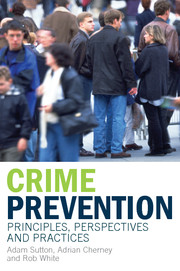2 - Key approaches and frameworks
from PART 1 - THEORY
Summary
Introduction
This chapter will discuss the following topics:
disputes and controversies in the crime prevention field;
assessing the value of crime prevention through technical and critical paradigms;
broad crime prevention classifications;
understanding crime in context;
community safety as a policy concept; and
the importance of crime prevention problem solving.
In attempting to prevent or reduce crime, it is essential that policy makers and practitioners be prepared to confront two fundamental questions. The first is ‘What are the underlying causes of offending?’. The second is ‘Which of these causes are most relevant to the crime or crimes currently being addressed?’. Providing answers to these questions is never straightforward. Almost invariably, therefore, crime prevention policy and practice will be contested.
Criminologists also have long pointed out that crime itself is a social construct. What is denoted as crime varies widely from society to society, and within a single society during different historical eras. For example, consumption of alcohol is legal in most contemporary Western countries, but is proscribed in some Islamic nations. Before beginning to develop and implement programs to prevent any form of offending it makes sense, therefore, to ask whether the relevant activity needs to be treated as crime in the first place.
This point has important practical implications. For example in Australia, the US and many other Western countries, a significant proportion of police apprehensions and court findings of guilt relate to the production, distribution and consumption of illicit drugs.
- Type
- Chapter
- Information
- Crime PreventionPrinciples, Perspectives and Practices, pp. 12 - 31Publisher: Cambridge University PressPrint publication year: 2008



